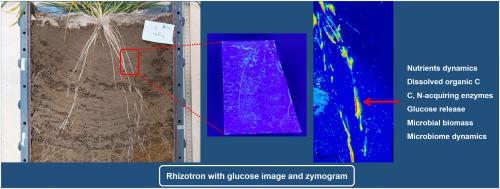当前位置:
X-MOL 学术
›
Soil Biol. Biochem.
›
论文详情
Our official English website, www.x-mol.net, welcomes your feedback! (Note: you will need to create a separate account there.)
Preceding crop legacy modulates the early growth of winter wheat by influencing root growth dynamics, rhizosphere processes, and microbial interactions
Soil Biology and Biochemistry ( IF 9.7 ) Pub Date : 2024-02-06 , DOI: 10.1016/j.soilbio.2024.109343 Nikolaos Kaloterakis , Mehdi Rashtbari , Bahar S. Razavi , Andrea Braun-Kiewnick , Adriana Giongo , Kornelia Smalla , Charlotte Kummer , Sirgit Kummer , Rüdiger Reichel , Nicolas Brüggemann
Soil Biology and Biochemistry ( IF 9.7 ) Pub Date : 2024-02-06 , DOI: 10.1016/j.soilbio.2024.109343 Nikolaos Kaloterakis , Mehdi Rashtbari , Bahar S. Razavi , Andrea Braun-Kiewnick , Adriana Giongo , Kornelia Smalla , Charlotte Kummer , Sirgit Kummer , Rüdiger Reichel , Nicolas Brüggemann

|
Successive winter wheat (WW) rotations are associated with a substantial yield decline, and the underlying mechanisms remain elusive. An outdoor experiment was set up using sandy loam soil. WW was grown in rhizotrons, in soil after oilseed rape (KW1), after one season of WW (KW2), and after three successive seasons of WW (KW4). We applied zymography and harvested the plants at the stem elongation stage to observe changes in the activity of -glucosidase (BGU) and leucine aminopeptidase (LAP), as well as using glucose (GLU) imaging to observe glucose release patterns in the rhizosphere of WW. Several biochemical and microbial properties of the bulk soil and the rhizosphere of the rotational positions were measured. KW2 and KW4 exhibited reduced plant biomass compared to KW1. There was a higher root length density and root mean diameter as well as a lower specific root length for KW1 compared to KW2 and KW4. KW1 soil had a lower mineral N concentration and microbial biomass carbon (C) and nitrogen (N) than KW2 and KW4, which translated to a lower plant C:N ratio. A greater rhizosphere extent of BGU and LAP across the soil profile was also visible for KW1 compared to KW2 and KW4 using zymography. Lower dissolved organic C and hotspot areas of GLU in the rhizosphere of successive WW might explain shifts in the microbial community composition, possibly leading to a dysbiosis with the soil microbes in the rhizosphere. Soil depth and rotational position explained most of the variance in the soil microbial communities. The relative abundance of , , , and significantly varied among the rotational positions. Our results highlight the effect of WW rotational positions on soil and plant properties, as well as microbial community dynamics, and provide evidence for the pathways driving biomass decline in successively grown WW.
中文翻译:

前期作物遗留物通过影响根系生长动态、根际过程和微生物相互作用来调节冬小麦的早期生长
连续的冬小麦(WW)轮作与产量大幅下降有关,但其潜在机制仍然难以捉摸。使用沙壤土进行了室外实验。WW在油菜后(KW1)、一季WW后(KW2)和连续三季WW后(KW4)在根际、土壤中生长。我们应用酶谱法并在茎伸长阶段收获植物来观察β-葡萄糖苷酶(BGU)和亮氨酸氨肽酶(LAP)活性的变化,并使用葡萄糖(GLU)成像来观察WW根际的葡萄糖释放模式。测量了大块土壤和旋转位置根际的几种生化和微生物特性。与 KW1 相比,KW2 和 KW4 表现出植物生物量减少。与 KW2 和 KW4 相比,KW1 具有较高的根长密度和根平均直径以及较低的比根长度。与 KW2 和 KW4 相比,KW1 土壤的矿物质氮浓度以及微生物生物量碳 (C) 和氮 (N) 较低,这意味着植物 C:N 比率较低。使用酶谱法还可以看出,与 KW2 和 KW4 相比,KW1 在整个土壤剖面上的 BGU 和 LAP 根际范围更大。连续WW根际中较低的溶解有机碳和GLU热点区域可能解释了微生物群落组成的变化,可能导致根际土壤微生物的生态失调。土壤深度和旋转位置解释了土壤微生物群落的大部分差异。、 、 和 的相对丰度在旋转位置之间显着变化。我们的结果强调了 WW 旋转位置对土壤和植物特性以及微生物群落动态的影响,并为驱动连续生长的 WW 生物量下降的途径提供了证据。
更新日期:2024-02-06
中文翻译:

前期作物遗留物通过影响根系生长动态、根际过程和微生物相互作用来调节冬小麦的早期生长
连续的冬小麦(WW)轮作与产量大幅下降有关,但其潜在机制仍然难以捉摸。使用沙壤土进行了室外实验。WW在油菜后(KW1)、一季WW后(KW2)和连续三季WW后(KW4)在根际、土壤中生长。我们应用酶谱法并在茎伸长阶段收获植物来观察β-葡萄糖苷酶(BGU)和亮氨酸氨肽酶(LAP)活性的变化,并使用葡萄糖(GLU)成像来观察WW根际的葡萄糖释放模式。测量了大块土壤和旋转位置根际的几种生化和微生物特性。与 KW1 相比,KW2 和 KW4 表现出植物生物量减少。与 KW2 和 KW4 相比,KW1 具有较高的根长密度和根平均直径以及较低的比根长度。与 KW2 和 KW4 相比,KW1 土壤的矿物质氮浓度以及微生物生物量碳 (C) 和氮 (N) 较低,这意味着植物 C:N 比率较低。使用酶谱法还可以看出,与 KW2 和 KW4 相比,KW1 在整个土壤剖面上的 BGU 和 LAP 根际范围更大。连续WW根际中较低的溶解有机碳和GLU热点区域可能解释了微生物群落组成的变化,可能导致根际土壤微生物的生态失调。土壤深度和旋转位置解释了土壤微生物群落的大部分差异。、 、 和 的相对丰度在旋转位置之间显着变化。我们的结果强调了 WW 旋转位置对土壤和植物特性以及微生物群落动态的影响,并为驱动连续生长的 WW 生物量下降的途径提供了证据。



























 京公网安备 11010802027423号
京公网安备 11010802027423号